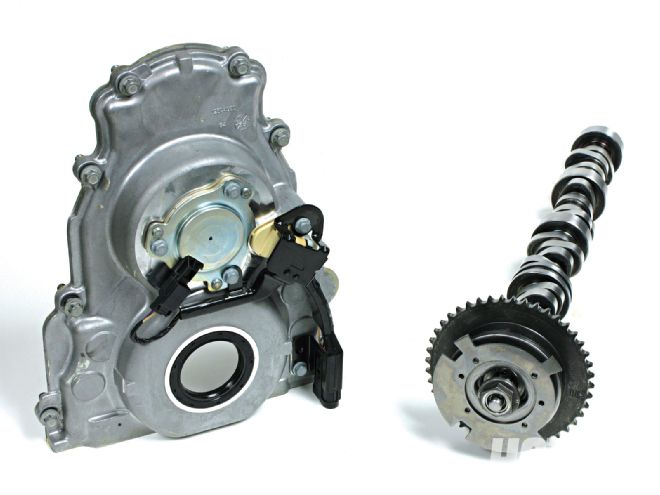
The tough guy in you says to stab that cam in retarded a few degrees for maximum top-end horsepower, while your more practical alter ego suggests advancing it a hair for improved low-end torque and driveability. As tempting as it may be to let your tough side deliver a swift kick to your practical side's shins, the installed centerline you settle on is often a compromise between the two extremes. However, as the Big Three have started integrating variable valve timing (VVT) into production V-8s, that needn't be the case anymore. Now you can have the best of both worlds.
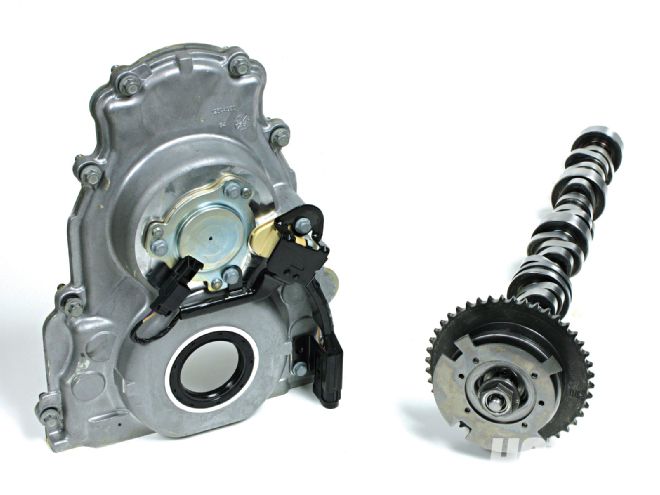 The three key components of GM's variable valve timing system are a VVT-specific camshaft, a phaser assembly, and a timing cover with an integrated electric solenoid. The setup is remarkably simple and consists of very few parts, which makes it easy to integrate into a non-VVT Gen III/IV small-block. The only other components necessary to complete a VVT swap are a 58-tooth reluctor wheel and either an ECM out of a factory VVT-equipped car or a stand-alone unit from Mast.
The three key components of GM's variable valve timing system are a VVT-specific camshaft, a phaser assembly, and a timing cover with an integrated electric solenoid. The setup is remarkably simple and consists of very few parts, which makes it easy to integrate into a non-VVT Gen III/IV small-block. The only other components necessary to complete a VVT swap are a 58-tooth reluctor wheel and either an ECM out of a factory VVT-equipped car or a stand-alone unit from Mast.
The performance potential for VVT in a hot rod motor is huge, but relatively few enthusiasts have embraced it. To test the merits of VVT in a high-performance application, we strapped one of Mast Motorsports' 600hp L99 small-blocks to the company's dyno and phased the cam back and forth to see its effects in action. By simply advancing and retarding the cam, the VVT system swung the peak horsepower and torque curves by 18 and 10 numbers, respectively. Furthermore, in the case of the all-important power after peak metric, the difference was as large as 41 hp. The beauty of VVT is that an improvement in high-rpm power doesn't sacrifice bottom-end torque, and in the case of GM LS-series small-blocks, it's extremely easy to retrofit onto any non-VVT motor.
Timing is Everything
How much, how long, and when the valves open and close all profoundly impact the shape of the power curve. Since lift and duration can't be changed without regrinding a camshaft, the only parameter that can easily be tweaked once the lobe profiles have been finalized is the cam timing (when the valve events take place in relation to the position of the crankshaft and therefore pistons). Among the valve events in a four-stroke internal combustion engine-intake valve opening, intake valve closing, exhaust valve opening, and exhaust valve closing-most engine builders agree that intake closing is king. In fact, some contend that intake closing is more important than the other three combined.
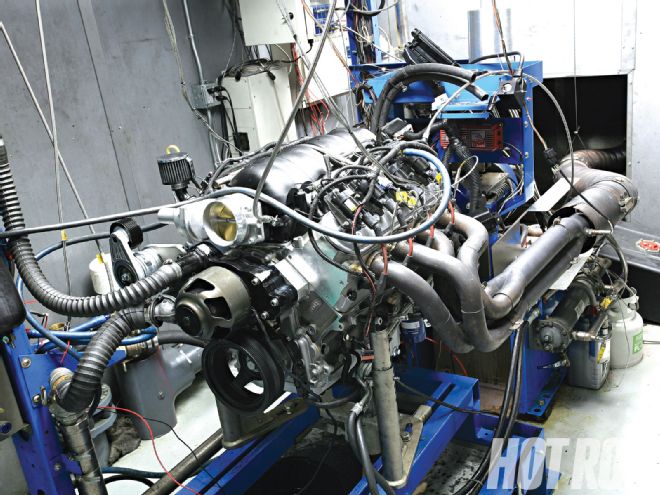 Serving as the test mule for our dyno session, Mast Motorsports' VVT-equipped L99 416 SS is based on a 6.2L aluminum block and has been bored and stroked to 416 ci using a forged Callies rotating assembly. Thanks to CNC-ported LS3 cylinder heads and a custom 236/250-at-0.050 hydraulic roller cam, the combo is rated at 595 hp. The $13,995 price includes a custom wiring harness and a Mast M-90 stand-alone computer.
Serving as the test mule for our dyno session, Mast Motorsports' VVT-equipped L99 416 SS is based on a 6.2L aluminum block and has been bored and stroked to 416 ci using a forged Callies rotating assembly. Thanks to CNC-ported LS3 cylinder heads and a custom 236/250-at-0.050 hydraulic roller cam, the combo is rated at 595 hp. The $13,995 price includes a custom wiring harness and a Mast M-90 stand-alone computer.
Simple physics dictates why this is the case. Internal combustion engines are nothing more than glorified air pumps, and the opening and closing of the intake valves determine how much air can be drawn into the cylinders on the intake stroke. With a typical performance camshaft, it's not uncommon for the intake valve to close up to 60 degrees after bottom dead center, which means after the piston has already started to move up during the compression stroke. This isn't ideal at low rpm, as the pistons will push the air/fuel mixture back past the intake valve and into the intake manifold, which hurts low-end torque and idle quality. On the other hand, a delayed intake closing point is exactly what an engine needs at high rpm.
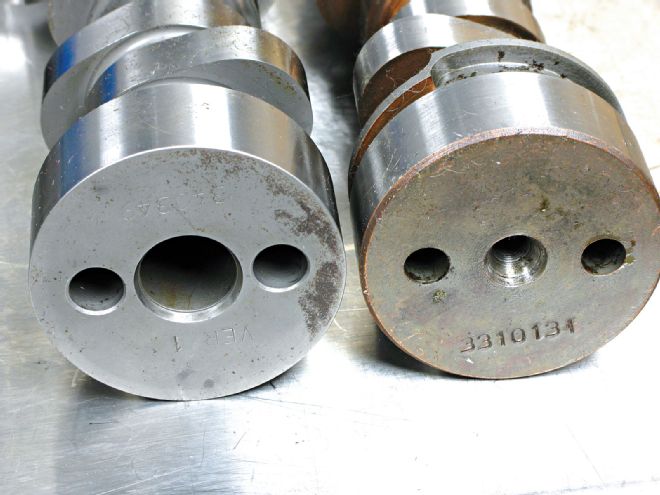 To facilitate the passage of oil, VVT camshafts (left) feature gun-drilled hollow cores. To take full advantage of the VVT system, the cam used in our test was ground on a 116-degree intake centerline, which is 6 to 10 degrees more retarded than on the average non-VVT cam. Since the ability to retard the cam improves high-rpm power, Mast's VVT cams don't require as much intake duration, which improves idle quality and low-rpm torque.
To facilitate the passage of oil, VVT camshafts (left) feature gun-drilled hollow cores. To take full advantage of the VVT system, the cam used in our test was ground on a 116-degree intake centerline, which is 6 to 10 degrees more retarded than on the average non-VVT cam. Since the ability to retard the cam improves high-rpm power, Mast's VVT cams don't require as much intake duration, which improves idle quality and low-rpm torque.
"As long as the inertial charge of the incoming air/fuel mixture is greater than the force exerted by the piston, the cylinder will still get filled with more air even as the piston moves back up the bore from BDC," explains Horace Mast of Mast Motorsports. "To take advantage of the pressure wave of air going into the cylinder at high rpm, it's imperative to close the intake valve at the right time, or else you're just wasting energy. That's why getting the intake closing point just right is so important, because closing it later allows more time for the cylinders to fill with air."
While the OEs often use VVT technology as a means of boosting fuel economy and cleaning up emissions, in performance applications, its primary purpose is to optimize the intake closing point. The intake and exhaust lobes are ground onto a single, in-block camshaft core on OHV motors like the Gen IV small-block, and phasing the cam means that all four valve events are changed in unison. Ideally, the intake and exhaust lobes should be phased independently, which requires either a DOHC design or a trick cam-in-cam layout like in the '08-and-up Dodge Viper V-10. Fortunately, the other three valve events are so inconsequential compared with intake closing that it's nothing to split hairs over. For instance, exhaust opening is most commonly accepted as the second most important valve event, as it contributes to determining the lobe-separation angle of a camshaft. Retarding exhaust opening improves bottom-end torque, while advancing it allows spent fumes to exit the cylinders sooner, which generally im-proves high-rpm power with long-duration camshafts. This is exactly the opposite of what happens when advancing or retarding intake closing, which means that optimizing intake closing actually compromises the exhaust opening point. Nonetheless, the effects of intake closing are so much more profound that the exhaust event really doesn't matter much.
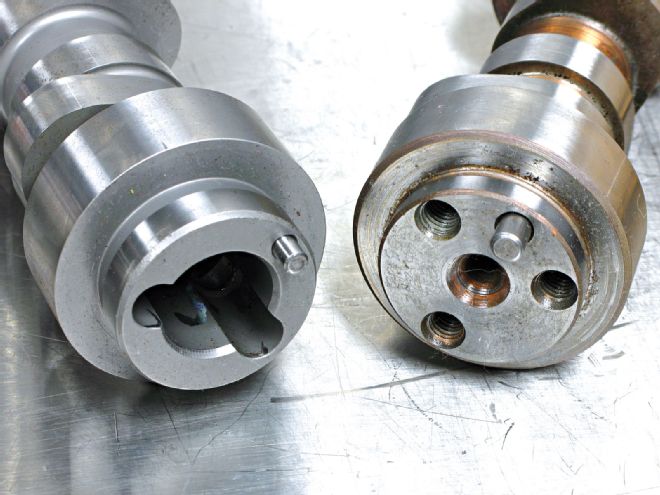 The VVT system robs oil from the No. 2 cam journal (right) and directs it to the front of the cam and then into the phaser assembly. Unlike the VVT setup used in Chrysler's 5.7L Hemi, GM didn't have to enlarge the cam bore diameter in the block, which makes adapting VVT to Gen III/IV small-blocks much more practical.
The VVT system robs oil from the No. 2 cam journal (right) and directs it to the front of the cam and then into the phaser assembly. Unlike the VVT setup used in Chrysler's 5.7L Hemi, GM didn't have to enlarge the cam bore diameter in the block, which makes adapting VVT to Gen III/IV small-blocks much more practical.
How VVT Works
Back in the Aug. '09 issue, we outlined the operational dynamics of the various variable valve timing systems used by the Detroit Three, so here's the condensed version of GM's setup. Much like the VVT systems in Ford's three-valve mod motors and Chrysler's 5.7L Hemi, the GM design utilizes a hydraulically actuated phaser integrated into the cam gear. The engine management computer and cam position sensor communicate with each other and send instructions to an electric solenoid mounted inside the timing cover. The solenoid then presses on a hydraulic valve bolted into the nose of the cam, which manipulates oil flow into the phaser assembly to advance or retard the cam.
 A Gen IV VVT camshaft can easily be identified by the petal-shaped recesses in its nose. The recesses route oil to the control valve that bolts the phaser to the cam.
A Gen IV VVT camshaft can easily be identified by the petal-shaped recesses in its nose. The recesses route oil to the control valve that bolts the phaser to the cam.
"The Gen IV's VVT system is very flexible and allows advancing the cam 7 degrees and retarding it 45 degrees for a total of 52 degrees of latitude. Piston-to-valve clearance can become an issue when you're moving the cam that far from the installed centerline, so we use Mahle pistons with big -4cc valve reliefs in our L99 crate engine packages," Mast says.
Big valve notches are just part of the package. Since the phaser assembly is essentially a rotor that moves inside of a stator, the only thing preventing the cam from wobbling erratically within its 52-degree range of travel is hydraulic pressure. "Even when you lock the cam phasing into a straight-up position, the engine management software is constantly adjusting oil pressure into the phaser to keep the cam in a fixed position. Otherwise, the pressure exerted on the phaser from the valvesprings could force it into full mechanical retard," Mast explains. Moreover, the fact that GM's VVT system relies on hydraulic pressure to overcome the force of the valvesprings means there's a practical limit to how much spring pressure it can handle. "On the dyno, we've noticed that once you exceed 380 pounds of open spring pressure, the VVT system starts losing control of the cam phasing at engine speeds above 5,000 rpm. Spring selection is critical on a VVT motor, and you can't get too aggressive with cam duration, either. Nonetheless, using a hydraulic roller cam and beehive valvesprings, we're still able to get 600 hp out of our VVT-equipped L99 crate motors," Mast says.
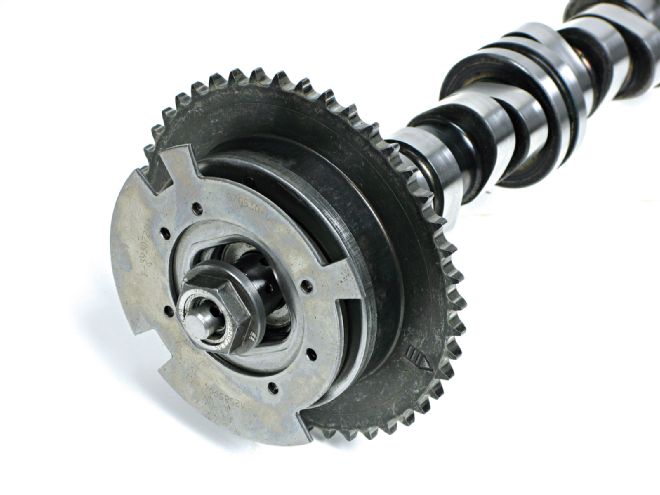 The phaser assembly replaces the cam gear, and its integrated rotor and vanes allow advancing and retarding the cam via hydraulic pressure. A camshaft position sensor mounted in the timing cover interfaces with a cam sensor wheel attached to the front of the phaser assembly. Holding the phaser to the cam is an oil control valve that doubles as a bolt.
The phaser assembly replaces the cam gear, and its integrated rotor and vanes allow advancing and retarding the cam via hydraulic pressure. A camshaft position sensor mounted in the timing cover interfaces with a cam sensor wheel attached to the front of the phaser assembly. Holding the phaser to the cam is an oil control valve that doubles as a bolt.
Pulling the Handle
To see if all this VVT hoopla works as well in the real world as it does in theory, we loaded one of Mast Motorsports' 416ci L99 crate motors into the dyno cell and thrashed away. Dubbed the L99 416 SS, Mast's combo features a 6.2L aluminum block bored to 4.070 inches, a Callies 4.000-inch steel crank and rods, Mahle 11.4:1 pistons, a custom Mast 236/250-at-0.050 hydraulic roller cam with 0.603/0.618-inch lift and a 114-degree lobe-separation angle, CNC-ported factory LS3 cylinder heads, and a stock L99 intake manifold. Mast conservatively rates the 416 at 595 hp. To test the virtues of the VVT system, we made several pulls on Mast's SuperFlow 902 dyno with the cam phased in three different positions: advanced for maximum torque, retarded for maximum horsepower, and with the VVT system engaged. Timing changes were performed on the fly using Mast's stand-alone M-90 ECM. The results were quite impressive to say the least.
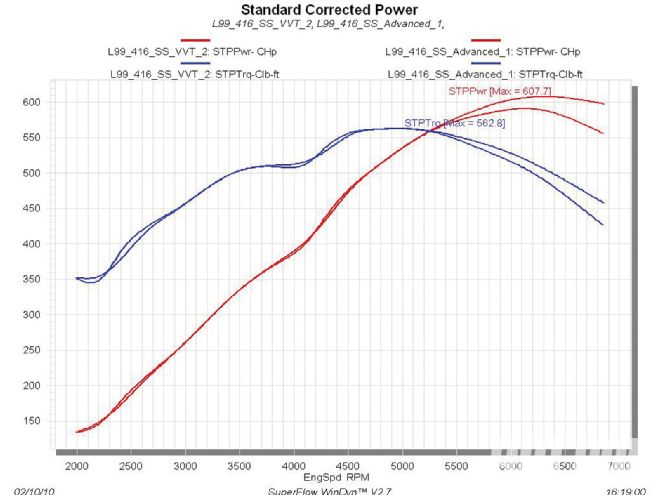 When comparing the dyno pull with VVT actuation and the pull with the cam retarded 4 degrees, the VVT system produces more power and torque from 2,000 to 6,000 rpm. Although peak power is the same in both dyno runs, the VVT produces more area under the curve. At 4,500 rpm, the VVT system has a 16hp advantage.
When comparing the dyno pull with VVT actuation and the pull with the cam retarded 4 degrees, the VVT system produces more power and torque from 2,000 to 6,000 rpm. Although peak power is the same in both dyno runs, the VVT produces more area under the curve. At 4,500 rpm, the VVT system has a 16hp advantage.
The L99 produced maximum torque with the cam advanced 5 degrees. In this configuration, the motor put out 591 hp at 6,100 rpm and 563 lb-ft at 5,000 rpm. When it came time to maximize peak hp, the 416 responded best to 4 degrees of retard. This arrangement yielded a peak output of 609 hp at 6,400 rpm and 553 lb-ft at 5,400 rpm. The results are precisely what would be expected, with the L99 making 10 lb-ft more at 400 fewer rpm with the cam advanced and 18 additional horsepower at 300 rpm higher in the powerband with the cam retarded. In a standard non-VVT motor, this would typically be the point where you'd have to decide to sacrifice low-end for top-end, top-end for low-end, or shoot for a happy medium between the two.
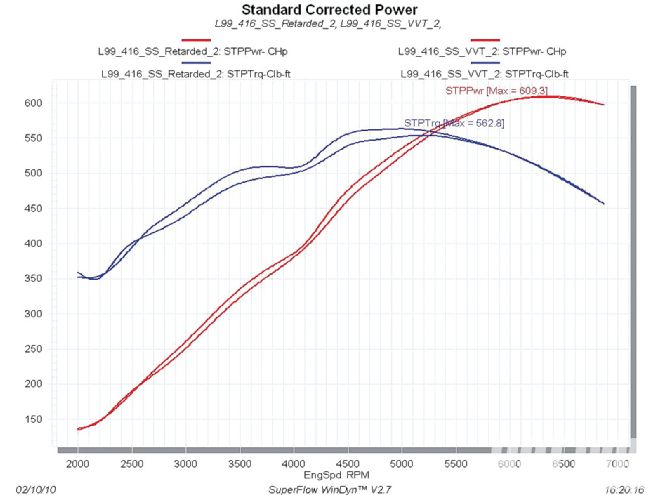 When overlaying the dyno graphs of the VVT pull and the dyno run with the cam advanced 5 degrees, the slopes of the power and torque curves are nearly identical from 2,000 to 5,300 rpm. After that point, the VVT system starts strutting its stuff, opening up a gap of 31 hp (604 versus 573) by 6,600 rpm and 41 hp (597 versus 556) by 6,900 rpm. In other words, while advancing the cam sacrifices a somewhat acceptable 17 peak horsepower, the VVT system annihilates the advanced phasing when it comes to power after peak.
When overlaying the dyno graphs of the VVT pull and the dyno run with the cam advanced 5 degrees, the slopes of the power and torque curves are nearly identical from 2,000 to 5,300 rpm. After that point, the VVT system starts strutting its stuff, opening up a gap of 31 hp (604 versus 573) by 6,600 rpm and 41 hp (597 versus 556) by 6,900 rpm. In other words, while advancing the cam sacrifices a somewhat acceptable 17 peak horsepower, the VVT system annihilates the advanced phasing when it comes to power after peak.
In theory, this is the sort of compromise VVT promises to eliminate, and on Mast's dyno, it did just that. With the VVT system switched on, the L99 cranked out 608 hp at 6,400 rpm and 563 lb-ft at 5,000 rpm. These dyno runs prove that the results live up to the hype, and VVT is quite literally the best of both worlds. Engaging the VVT system yielded horsepower and torque output that was spot on to the prior tests in which the cam was retarded for max power and advanced for max torque. Sure, the motor made 1 hp less on the VVT dyno pull, but that's well within the 1/2 percent run-to-run variation limit of what's considered acceptable for even a very consistent dyno cell. What's most astonishing, however, is the difference in power after peak when comparing the dyno numbers with the cam advanced versus the dyno numbers with VVT enabled. At 6,900 rpm, the advanced dyno pull netted 556 hp, while the VVT run produced 597 hp. That's a difference of 41 hp. Timing really is everything.
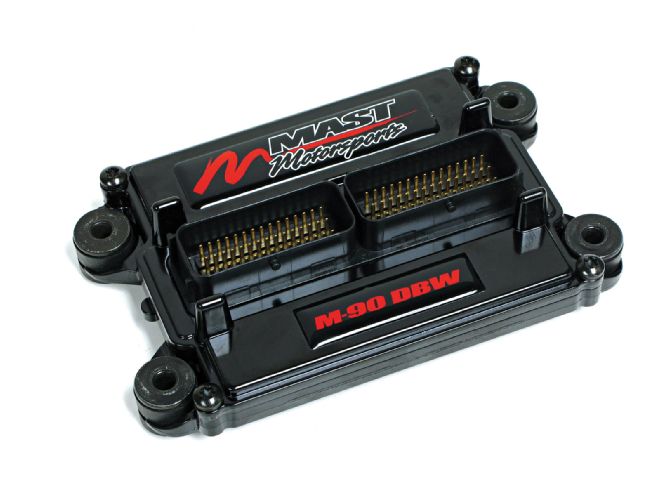 Variable valve timing didn't debut in LS-series motors until 2007, so finding a factory computer capable of controlling VVT operation can be a chore. An easy fix is Mast's stand-alone M-90 ECM. In addition to having the necessary tables to actuate the VVT system, it is far easier to program than a stock computer and lists for $890.
Variable valve timing didn't debut in LS-series motors until 2007, so finding a factory computer capable of controlling VVT operation can be a chore. An easy fix is Mast's stand-alone M-90 ECM. In addition to having the necessary tables to actuate the VVT system, it is far easier to program than a stock computer and lists for $890.
VVT Swap Part List
The beauty of GM's VVT system is in its simplicity. Bolt up a VVT-specific timing cover, phaser assembly, cam bolt, and 58-tooth reluctor wheel to any Gen III/IV small-block-which can all be purchased from Scoggin-Dickey (sdpc2000.com) for a total of $245-and you're almost ready to get variably timed. To control it all, you'll also need a Mast computer and wiring harness and a VVT cam from a company such as Mast or Comp. The retrofit isn't exactly cost effective for cars already powered by LS-series motors, but for anyone building a Gen III/IV motor from scratch to drop into a muscle car, all the components necessary for pulling off a VVT swap are parts you'd have to purchase anyway.
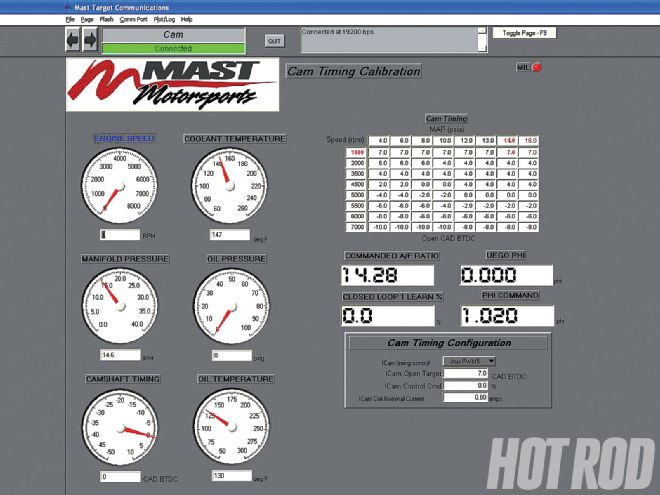 Mast's M-90 ECM allows changing cam phasing based on rpm and intake manifold pressure. Although the L99 416 made the best torque with 5 degrees of advance and the most power with 4 degrees of retard, the M-90 software actually phased the cam a total of 15 degrees between idle and 7,000 rpm. At idle, the cam was advanced 7 degrees, and by 7,000 rpm, the cam was retarded 8 degrees. This explains the dramatic differences in power at 6,900 rpm between the VVT dyno pull and the advanced dyno run.
Mast's M-90 ECM allows changing cam phasing based on rpm and intake manifold pressure. Although the L99 416 made the best torque with 5 degrees of advance and the most power with 4 degrees of retard, the M-90 software actually phased the cam a total of 15 degrees between idle and 7,000 rpm. At idle, the cam was advanced 7 degrees, and by 7,000 rpm, the cam was retarded 8 degrees. This explains the dramatic differences in power at 6,900 rpm between the VVT dyno pull and the advanced dyno run.
ITEM PN PRICE L92/L99 timing cover 12616491 $120.00 Phaser assembly 12585994 66.00 Cam bolt/valve 12588151 37.00 58-tooth reluctor wheel 12586768 22.00 Mast M-90 ECM and harness M-90DBW 1,665.00 Total $1,910.00